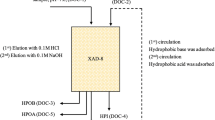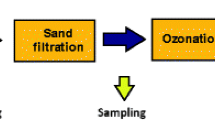Abstract
Dissolved organic matter (DOM) in wastewater and reclaimed water is related to water quality, safety, and treatability. In this study, DOM was characterized through a fingerprint analysis method for DOM characterization using resin fractionation followed by size exclusion chromatography (SEC). Resin fractionation was used in the first step to divide the DOM in water samples into six resin fractions, namely, hydrophobic acids (HOA), hydrophobic bases (HOB), hydrophobic neutrals (HON), hydrophilic acids (HIA), hydrophilic bases (HIB), and hydrophilic neutrals (HIN). SEC analysis was then performed to separate each resin fraction into several (n) subfractions with different molecular weights (MW). Thus, the total DOM in the water sample was fractionated into 6n subfractions. After quantification of each subfraction by dissolved organic carbon (DOC), a fingerprint graph was constructed to express the distribution of DOM in the subfractions. The fingerprint analysis method was applied to a secondary effluent sample during ozonation. Ozonation (dose of 10 mg L−1) removed the DOC only by 8 % and reduced UV254 of the sample by 36 %. Fingerprint graphs also revealed that the resin fractions changed quite limitedly but transformation of subfractions occurred notably.





Similar content being viewed by others
References
Bellar TA, Lichtenberg JJ, Kroner RC (1974) The occurrence of organohalides in chlorinated drinking water. J Am Water Works Ass 66:703–703
Chen W, Westerhoff P, Leenheer JA, Booksh K (2003) Fluorescence excitation–emission matrix regional integration to quantify spectra for dissolved organic matter. Environ Sci Technol 37:5701–5710
Gong JL, Liu YD, Sun XB (2008) O-3 and UV/O-3 oxidation of organic constituents of biotreated municipal wastewater. Water Res 42:1238–1244
Imai A, Fukushima T, Matsushige K, Kim YH, Choi K (2002) Characterization of dissolved organic matter in effluents from wastewater treatment plants. Water Res 36:859–870
Jarusutthirak C, Amy G, Croué JP (2002) Fouling characteristics of wastewater effluent organic matter (EfOM) isolates on NF and UF membranes. Desalination 145:247–255
Leenheer JA (1981) Comprehensive approach to preparative isolation and fractionation of dissolved organic carbon from natural waters and wastewaters. Environ Sci Technol 15:578–587
Levine AD, Tchobanoglous G, Asano T (1985) Characterization of the size distribution of contaminants in wastewater: treatment and reuse implications. J Water Pollut Control Fed 57:805–816
Matilainen A, Gjessing ET, Lahtinen T, Hed L, Bhatnagar A, Sillanpää M (2011) An overview of the methods used in the characterization of natural organic matter (NOM) in relation to drinking water treatment. Chemosphere 83:1431–1442
Mitch WA, Sedlak DL (2004) Characterization and fate of N-nitrosodimethylamine precursors in municipal wastewater treatment plants. Environ Sci Technol 38:1445–1454
Mitch WA, Sharp JO, Trussell RR, Valentine RL, Alvarez-Cohen L, Sedlak DL (2003) N-nitrosodimethylamine (NDMA) as a drinking water contaminant: a review. Environ Eng Sci 20:389–404
Morrison RT, Boyd RN (1983) Organic chemistry. Allyn & Bacon, Newton
Muellner MG, Wagner ED, McCalla K (2007) Haloacetonitriles vs. regulated haloacetic acids: are nitrogen-containing DBPs more toxic? Environ Sci Technol 41:645–651
Park MH, Lee TH, Lee BM, Hur J, Park DH (2010) Spectroscopic and chromatographic characterization of wastewater organic matter from a biological treatment plant. Sensors 10:254–265
Petala M, Samaras P, Zouboulis A, Kungolos A, Sakellaropoulos GP (2008) Influence of ozonation on the in vitro mutagenic and toxic potential of secondary effluents. Water Res 43:4929–4940
Shon HK, Vigneswaran S, Snyder SA (2006) Effluent organic matter (EfOM) in wastewater: constituent, effects, and treatment. Crit Rev Environ Sci Technol 36:327–374
Thurman EM (1985) Organic geochemistry of natural waters. Martinus Nijhoff/Dr W Junk, Dordrecht
Wang LS, Hu HY, Wang C (2007) Effect of ammonia nitrogen and dissolved organic matter fractions on the genotoxicity of wastewater effluent during chlorine disinfection. Environ Sci Technol 41:160–165
Weishaar JL, Aiken GR, Bergamaschi BA (2003) Evaluation of specific ultraviolet absorbance as an indicator of the chemical composition and reactivity of dissolved organic carbon. Environ Sci Technol 37:4702–4708
Wu QY, Hu HY, Zhao X, Sun YX (2009) Effect of chlorination on the estrogenic/antiestrogenic activities of biologically treated wastewater. Environ Sci Technol 43:4940–4945
Wu QY, Hu HY, Zhao X, Li Y (2010) Effects of chlorination on the properties of dissolved organic matter and its genotoxicity in secondary sewage effluent under two different ammonium concentrations. Chemosphere 80:941–946
Wu QY, Li Y, Hu HY, Ding YN, Huang H, Zhao FY (2012) Removal of genotoxicity in chlorinated secondary effluent of a domestic wastewater treatment plant during dechlorination. Environ Sci Pollut Res 19:1–7
Zhang H, Qu JH, Liu HJ, Zhao X (2009) Characterization of isolated fractions of dissolved organic matter from sewage treatment plant and the related disinfection by-products formation potential. J Hazard Mater 164:1433–1438
Zhang X, Zhao X, Zhang M, Wu QY (2011) Safety evaluation of an artificial groundwater recharge system for reclaimed water reuse based on bioassays. Desalination 281:185–189
Acknowledgments
This study was funded by National Science Fund of China (No. 51208278/51138006), National High-tech R&D Program of China (863 Program No. SS2013AA061805), and the Collaborative Innovation Center for Regional Environmental Quality.
Author information
Authors and Affiliations
Corresponding author
Additional information
Responsible editor: Angeles Blanco
Electronic supplementary material
Below is the link to the electronic supplementary material.
ESM 1
Two methods, one table and three figures present detailed information on DOM fractionation method with resins (Method S1), fluorescence spectroscopy analysis (Method S2), integration values of SEC-fractions and subfractions in a DOM sample (Table S1), schematic diagram of DOM fractionation procedure (Fig. S1), EEM fluorescence spectra of the resin-fraction HOA of the samples before and after ozonation (Fig. S2) and SEC chromatograms of the resin-fractions of the samples before and after ozonation (Fig. S3). (DOC 324 kb)
Rights and permissions
About this article
Cite this article
Tang, X., Wu, QY., Zhao, X. et al. A fingerprint analysis method for characterization of dissolved organic matter in secondary effluents of municipal wastewater treatment plant. Environ Sci Pollut Res 21, 14211–14218 (2014). https://doi.org/10.1007/s11356-014-3336-3
Received:
Accepted:
Published:
Issue Date:
DOI: https://doi.org/10.1007/s11356-014-3336-3




